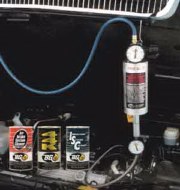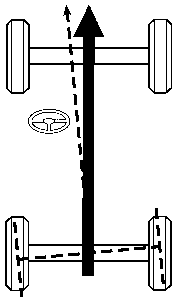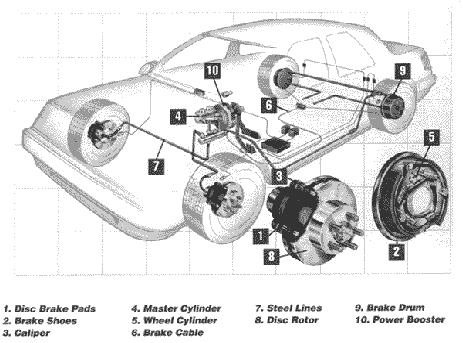AlternativePerformance.com | home
About Us | News and Events | Location | FAQ | Contact Us | Jeep CJ7 EFI Conversion | EFI Conversion Part 2
FAQ
There is no safer and more economical way to preserve your peace of mind, than to have regular, complete diagnostic checkups performed by AlternativePerformance.com technicians trained to spot potential problems before they occur. These checkups can prevent the high cost and hassle of major repairs down the road by letting us find the little problems before they become big ones.
Remember how much fun it was to drive your car when it was new?
Without your realizing it, the response and performance that made driving your new car so much fun have slowly drained away.
Deposits that buildup in the fuel and air induction systems of the engine have robbed your car of its agility and excitement.

Modern engines are finely tuned and extremely sensitive to deposits that accumulate on intake valves (pictured on the left), intake ports, fuel injectors and combustion chamber Deposits in the fuel induction system cause drivability problems such as hesitation, surge,stall, hard starting, rough idle and loss of power.
The correct balance of fuel and air entering the combustion chamber is vital to engine performance.
The air throttle body assembly controls the airflow into the intake ports where the air mixes with atomized fuel and swirls into the combustion chamber. Heavy deposits buildup on the backside of the throttle plate, around and behind the plate and in the idle air control.
Deposits in the air induction system cause rough engine idle, excessive exhaust emissions and loss of performance.
Correct fuel/air ratio can be maintained only when the fuel and air induction systems are clean and free of deposits.
Deposits can be cleaned away, restoring your car's performance. Highly effective cleaners are applied by our technicians utilizing specialized equipment. In about two hours, we'll clean your car's entire fuel and air induction systems. For the first time in a long time, you'll have that great new-car feeling again!
Straight Talk About 4-Wheel Alignment
What Is 4-Wheel Alignment?
Simply put, the front wheels steer the car. But the thrust, or direction of travel for the car, is determined by the rear axle. This is true for any car, even for front-wheel drive models.
Confusing? Not really. Imagine a line that divides your car in half, lengthwise. If the rear axle is aligned correctly, the thrust line will match this centerline exactly.
If, however, the thrust line is off to the left or right, the car will attempt to travel in that direction.
After 4-wheel alignment, all four wheels on your car will be parallel. Handling performance will be higher, tread wear will be lower.
Does Your Car Need It?
Here's the general rule of thumb. Any vehicle with adjustable rear suspension is a candidate for 4-wheel alignment. To be sure, have AlternativePerformance.com alignment specialists check this for you.
The following list can serve as a handy guide. All of these makes include models with adjustable rear suspension.
BMW • Chrysler • Datsun/Nissan •
Ford • Honda • General Motors • Jaguar
Mazda • Mitsubishi • Mercedes • Peugeot • Porsche
Volkswagon • Toyota • Volvo

Three Basic Alignment Types
Front Wheel Alignment Here, using the car's centerline as a reference, the caster, camber and toe are adjusted. This alignment is satisfactory if the thrust line matches the centerline. If they are different; the steering wheel may be cocked while driving straight ahead.
4-Wheel Compensated Alignment Again, the front-wheel caster, camber and toe are checked and adjusted. But this time the adjustments are made with reference to the rear-wheel thrust line. In addition, the rear-wheel camber and toe are checked. Recommended for cars without rear-wheel adjustment capabilities.
Deluxe 4-Wheel Alignment This is the ultimate in 4-wheel alignment. Here, the rear-wheel camber and toe are adjusted, aligning the thrust line with the centerline. Then, the front wheels are aligned (caster, camber, toe) with the thrust line. Since both the centerline and thrust line are now the same, all four wheels will be parallel. When you're driving straight ahead, both the steering wheel and the car will be straight.
The Simple Equation
Your vehicle's brake system uses a master cylinder, calipers or wheel cylinders and a network of hoses and steel lines to hold the system's life blood - brake fluid - under pressure. It is this fluid pressure that makes modern braking systems so safe and reliable. When you step on the brake pedal, the master cylinder transmits the force from your foot pressure to the brake fluid in the hoses and lines. In turn, the pressurized brake fluid pushes the wheel cylinders on drum brakes or calipers on disc brakes. This movement of fluid causes the internal parts of the wheel cylinder or caliper to move outward, pushing the brake shoes or disc pads against the brake drum or rotor. The contact between these parts causes friction (heat), which brings your car to a controlled stop.
New Technology Means Greater Heat
In the past, you could remove your foot from the gas pedal and your car would rapidly slow down.....even before you touched the brake pedal. However, the aerodynamic design of today's vehicles actually assists your car's forwsp;&movement. New braking technology provides for much smaller component parts; and front wheel drive vehicles have transferred 80 percent of the braking function to the front disc brakes. All of these factors subject your car's brakes to temperatures that are hundreds of degrees hotter than brake systems of 10 years ago. Increased heat and harder work mean greater wear on parts. On vehicles equipped with semi-metallic brake pads, some braking noise is considered common. This noise often occurs because smaller parts absorb less noise. The best answer to noise, wear and safety is completed brake service. And it takes well trained technicians in a reputable service establishment to perform the type of service that will restore your vehicle's brakes to "new car" performance standards and save you more costly repairs down the road.
The Extra Mile
Your car's brakes provide a level of safety unmatched by any other system; you simply can't afford to cut corners when servicing this vital network of components. Besides the pads and shoes, here are other parts of the system that need to be inspected by a trained technician every 10,000 miles:
Master (4) cylinder and booster (10)
Lines (7) and hoses
Calipers (3)
Wheel cylinders (5)
Rotors (8) and drums (9)
Parking brake cables (6)
Brake fluid
a by a trained technician every 10,000 miles:

There are multiple evolutions in brake technology that make complete brake inspection and service a crucial part of the preventative maintenance required by today's complex automobiles:
Dollars and Sense
To make your system stays reliable, it's crucial that you have your vehicle's brakes inspected periodically. And, it is equally important to make sure it is a complete inspection, performed by a trained technician. Unfortunately, wear on brakes shoes and pads is the only wear that's easily visible, so the rest of the brake system's components can be overlooked or ignored until it is too late. Worn out parts can cause damage to other system components. Once this occurs, replacement and service becomes a great deal more costly. Some brake shops advertise lowball prices for shoe or pad replacement, then tack on the extra costs for a complete repair job once your car is in the bay. Remember, if a deal sounds too good to be true, it probably is. Don't be afraid to ask questions.
Air Conditioning System
Have You Had Your Air Conditioning System Inspected Lately?
What's In Store
Clearly, servicing your car's air conditioning system is something that shouldn't be taken lightly. To do it correctly now days, it takes refrigerant recovery and recycling equipment as well as technicians certified in the use of this equipment. The services may cost a little more than what you're accustomed to, but with the potential cost of neglect to your car and the environment, it's a small cost for peace of mind. You can be assured that these annual inspections will help your air conditioning system keep its cool.
These Warning Signs Could Mean Costly Repairs Down The Road
Environmentally Speaking
There was a time you simply flipped on your air conditioner in the Spring to see if the air coming from the outlets was cold. If the temperature seemed too warn, you merely brought the car in and had some refrigerant added. At one point, it was even considered normal for an air conditioning system to lose a pound of refrigerant per year. Since that time, attitudes about refrigerant loss have changed drastically. That's because scientists have concluded that R-12 refrigerant, a Chlorinated Fluorocarbon (CFC) also known as FREON, is partly responsible for depletion of the earth's ozone layer. To reduce the loss of refrigerant, car manufacturers now make their systems much more leak-resistant by using improved materials for lines, hoses and seals. Federal and state regulations also require that repair shops have the correct equipment and training for handling refrigerant.
Dollars and Sense
A low refrigerant charge can cause major damage to your car's air conditioner. Unlike some compressors used in the '70s, which had their own oil supply, most current designs rely on a sufficient refrigerant charge to carry oil through the system. If that charge is lost - either partially or completely - the compressor may starve for oil and fail shortly thereafter. This results in a major expense, not only for the compressor, but for related items that will have to be replaced if the compressor fails.
Computer in my car?
Your car's on-board computer doesn't look anything like the kind that's used on a desktop. The "computer" is a small box called an PCM (Power train Control Module), often mounted behind the glove box or in the engine compartment. The PCM controls all the essentials of engine operation: Spark timing, fuel delivery, emissions, and in some cases even the air conditioning or the automatic transmission. Keeping all those systems in tiptop shape is no simple job; it requires complex test equipment and advanced diagnostic skills.
The computer continuously receives electrical signals from sensors and input devices, located in and around the engine. It analyzes this information and sends a stream of control signals to valves, controllers and other output devices, to balance the requirements of power, fuel economy and emission control. Some of the most common devices are shown in this brochure. Every engine, every car and every computer system is different - but all the sensors, all the output devices, must be in perfect "sync" for the car to run properly.
No system is foolproof. When problems develop, the malfunctioning parts must be replaced or adjusted. Otherwise the car won't run right, the gas mileage will be poor, and the car won't pass an emissions inspection. Only a qualified technician, with the right diagnostic equipment and technical data, can find out what's wrong and restore your car to original performance specifications.
What For These Warning Signs That Tell You Your Vehicle Needs Service
The Professional Difference
The old-fashioned tune-up used to be done "by ear", but this isn't possible with computer-controlled engines. A complete diagnostic check, followed by professional service, should be performed at factory-recommended intervals, or whenever your car shows any of the above warning signs. Our Expert technicians can:
Tune-up
Is it time for a Tune-up Yet?
It's been a couple of years since you had the car tuned up but it still seems to be running fine. Leave well enough alone, right?
Wrong!
On most vehicles today, malfunctions may be camouflaged by computers whose function is to keep the engine running as efficiently as possible as long as possible. When they no longer can compensate for mechanical discrepancies, they may just fail. The vehicle is disabled. Periodic diagnostic checks and maintenance can prevent this sometimes disastrous situation.
Symptoms of engine trouble on most vehicles today are subtle. It's not easy to tell if your car needs a tune-up because the symptoms are masked by computerized controls. Preventive diagnosis, done periodically, can keep your vehicle running trouble-free for years. Short of that, if you do detect a change in your vehicle's performance, make a note of it and report it to your AlternativePerformance.com technician for further diagnosis and corrective measures.
The Eight Most Common Signs Your Car Needs a Tune-up
Hard Starting
This is the most common form of car trouble. It's usually due to some unperformed maintenance. If the starter cranks the engine, the electrical system probably is OK. The culprit could be a starting sensor (on fuel injected models) or the choke mechanism (on engines with carburetors). Frequently, starting failure can be traced to an electronic component or a computer controlling the ignition system.
Knocking
This noise generally is heard when the engine is under load, such as when accelerating or climbing a hill. While it often may be caused by a tank full of inferior gas, ignition knock frequently is a sign your engine needs attention. It also can be caused by a buildup of carbon inside the engine.
Late model cars are equipped with a knock sensor which "hears" the sound and makes corrective adjustments. But it cannot compensate for a severe malfunction, a condition which can affect engine performance, even damage the engine.
Stalling
This can be caused by incorrect idle speed adjustments, a malfunctioning sensor or switch, dirty fuel system parts, worn spark plugs or other engine deficiencies. Does it stall when:
To make diagnosis easier, make note of when it happens and advise your technician.
Power Loss
How long since the fuel filter was changed? A dirty filter is a common cause of power loss. As noted under "poor gas mileage", there can be many causes of this condition, most of which can be located with a diagnostic procedure.
Poor Gas Mileage
By keeping a regular check of gas mileage (miles driven divided by gallons used) you can tell if your engine is losing efficiency. Increased gas consumption may be accompanied by other symptoms listed in this section.
Note - Poor gas mileage also may be due to:
Dieseling
This also is known as "after-run". The engine keeps chugging and coughing for several seconds or more after the ignition is shut off. Causes can range from inferior gas to excessive idle speed. Carbon in the combustion chamber also may cause dieseling.
Exhaust Odor
The smell of rotten eggs comes from the catalytic converter, part of your car's emissions control system. The odor can be due to an engine problem or it can be a sign your car's catalytic converter is malfunctioning.
Rough Running
A malfunction in either the fuel or ignition system can cause an engine to run rough. It also can be due to an internal engine condition, such as a bad valve or piston. Does it occur when idling? When accelerating? At all speeds? Your best bet: Have AlternativePerformance.com perform diagnostic and tune-up as needed.
About Us · News and Events · Location · FAQ · Contact Us · Jeep CJ7 EFI Conversion · EFI Conversion Part 2